Review and Assessment of Fatigue Delamination Damage of Laminated Composite Structures
Abstract
:1. Introduction
2. Experiment and Mechanism of Fatigue Delamination
2.1. Delamination Test
2.1.1. Pure Mode Delamination Test
2.1.2. Mixed-Mode Delamination Test
2.1.3. Other Delamination Tests
2.2. Characterization for Fatigue Delamination
2.2.1. Fatigue Delamination Onset
2.2.2. Fatigue Delamination Propagation
2.3. Influencing Factors of Fatigue Delamination
2.3.1. The Mixed-Mode Ratio
2.3.2. Fiber Bridging Effect
2.3.3. The Load Ratio
2.3.4. Other Major Factors
2.3.5. Other Secondary Factors
3. Phenomenological Model of Fatigue Delamination
3.1. Calculation of the SERR
3.1.1. The VCCT
3.1.2. The J-Integral Method
3.2. Delamination Onset Phenomenological Model
3.3. Delamination Propagation Phenomenological Model
3.3.1. Mixed-Mode Ratio Modified Model
3.3.2. Fiber Bridge-Modified Model
3.3.3. Load Ratio-Modified Model
3.3.4. Temperature-Modified Model
4. Finite Element Simulation of Delamination Fatigue
4.1. Strength Model
4.2. Fracture Mechanics Model
- Artificial pre-cracks are added to composite laminated structures. Set the growth path of crack propagation and adapt the displacement load mode.
- When structure is applied fatigue load, it is assumed that f n(K or G) is constant during the increase in fatigue crack length (∆a)n. The general Paris law is converted into its incremental form, as shown in Equation (22):
- The SERR (G) of n step can be obtained using FEM methods such as the VCCT and the J-integral method. The procedure of calculation has been introduced in Section 3.1 (once the fatigue load is determined, the SERR (G) can be determined). After selecting the function of f (K or G), fn(K or G) around the crack tip in n step can be calculated.
- Up till now, (∆a)n and fn(K or G) can be obtained from the previous steps. After substituting (∆a)n, fn(K or G), and known experimental fitting coefficients C and m into Equation (22), (∆N)n can be finally obtained. It should be noticed that C and m can present material constants or functions of parameters, such as fatigue crack length (a).
- Updating fatigue cycle number Nn+1 of the (n + 1) step using Equation (23). The structural stiffness declines as a result of delamination damage. Go back to step 2 and calculate delamination propagation of next incremental step until it stops when fn(K or G) ≤ fn(K or G)th. Record the final fatigue crack length (a) and fatigue cycle (N). fn(K or G)th is the inherent properties of the material, which is obtained by experimenting with the fatigue crack growth rate.
4.3. Damage Mechanics Model
4.3.1. Intra-Laminar Element Model
4.3.2. Inter-Laminar Element Model
- (1)
- Derive the stiffness matrix and the constitutive equation (that is the cohesive law) of cohesive elements.
- (2)
- Determine the damage initiation and evolution criteria of mixed-mode fatigue delamination.
- (3)
- (4)
- Establish the differential relationship between the damage variables and the number of fatigue cycles. Then, a reasonable formula for the fatigue delamination damage rate can be obtained.
- (5)
- Select the inter-laminar parameters of fatigue delamination damage that need to be degraded. Then, establish the functional relationship between the degradation parameters and the damage variables.
- (6)
- Realize the loading/unloading cycles of FDDMs using ABAQUS software 6.14 and formulate the standard of integral structure failure. Finally, fatigue cycles of delamination under a specific fatigue load can be calculated.
4.3.3. Mixed Intra-Laminar/Inter-Laminar Element Model
4.4. Hybrid Model
5. Summary and Prospects
- (1)
- The traditional continuum damage models (CDMs) [126] have been extensively used for capturing intra-laminar damage mechanisms like fiber breaking and matrix cracking, which result in the development of CZMs [117] for inter-laminar delamination. However, the simulation accuracy of fatigue delamination in many models greatly depends on the mesh density around the crack tip. Therefore, the multi-scale CZM [163,164] fatigue delamination model for crack tip tracking [21,144] came into existence, which simultaneously considers both global and local models;
- (2)
- As an extension of the traditional FEM, the extended finite element method (XFEM) can expand the degree of freedom (DOF) of elements with displacement functions to obtain discontinuities responses [6]. The XFEM has the ability to predict local stress fields and stress concentration fields accurately without refining meshes. In addition, this method can predict delamination propagation without pre-cracks, which are obvious prior to the CZM [165]. Some investigators have applied the XFEM to analyze fatigue delamination onset and propagation [166];
- (3)
- It is difficult for traditional FDDMs to solve the problem of spatial delamination for angle-ply laminated composite structures. In the last decade, the phase field (PF) approach to brittle fracture has emerged as a reliable alternative method for modeling the progressive failure of composite materials [167,168]. On the basis of the PF, researchers have established a PF-CZM approach [169,170] for modeling the delamination propagation of composite materials;
- (4)
- The vital idea of isogeometric analysis (IGA) is to apply non-uniform rational B-splines (NURBSs) to approximate solution fields in the FEM. Some investigators [171] have found that shear stresses provided by the FEM models exhibit prominent oscillatory behaviors, while the IGA models show fewer oscillations and yield more precise solutions. This implies that there is the potential to employ IGA to track the crack growth of irregular geometric models;
- (5)
- The capture of delamination propagation greatly depends on the accurate prediction of inter-laminar stresses. To the best of the authors’ knowledge, it is extremely effective to obtain inter-laminar stress via the high-order deformation theory (HODT). Some researchers have constructed higher-order composite beam/plate/shell elements [172,173] to predict the delamination and critical load of composite laminated structures;
- (6)
- It can be found that the phenomenological model based on tremendous observations is still an important way to study fatigue delamination onset and propagation. The machine learning models are suitable for cases where the amount of available data is large and the physics-based mathematical approaches are complex. Therefore, it is natural to integrate the machine learning models into the data processing of the phenomenological delamination model [174,175,176,177,178].
Author Contributions
Funding
Institutional Review Board Statement
Informed Consent Statement
Data Availability Statement
Conflicts of Interest
References
- Bak, B.L.V.; Sarrado, C.; Turon, A.; Costa, J. Delamination Under Fatigue Loads in Composite Laminates: A Review on the Observed Phenomenology and Computational Methods. Appl. Mech. Rev. 2014, 66, 060803. [Google Scholar] [CrossRef]
- Daneshjoo, Z.; Amaral, L.; Alderliesten, R.; Shokrieh, M.; Fakoor, M. Development of a Physics-Based Theory for Mixed Mode I/II Delamination Onset in Orthotropic Laminates. Theor. Appl. Fract. Mech. 2019, 103, 102303. [Google Scholar] [CrossRef]
- Carraro, P.A.; Maragoni, L.; Quaresimin, M. Characterisation and Analysis of Transverse Crack-Induced Delamination in Cross-Ply Composite Laminates under Fatigue Loadings. Int. J. Fatigue 2019, 129, 105217. [Google Scholar] [CrossRef]
- Gong, Y.; Zhao, L.; Zhang, J.; Hu, N.; Zhang, C. An Insight into Three Approaches for Determining Fatigue Delamination Resistance in DCB Tests on Composite Laminates. Compos. Part B Eng. 2019, 176, 107206. [Google Scholar] [CrossRef]
- Bak, B.L.V.; Turon, A.; Lindgaard, E.; Lund, E. A Benchmark Study of Simulation Methods for High-Cycle Fatigue-Driven Delamination Based on Cohesive Zone Models. Compos. Struct. 2017, 164, 198–206. [Google Scholar] [CrossRef]
- Heidari-Rarani, M.; Sayedain, M. Finite Element Modeling Strategies for 2D and 3D Delamination Propagation in Composite DCB Specimens Using VCCT, CZM and XFEM Approaches. Theor. Appl. Fract. Mech. 2019, 103, 102246. [Google Scholar] [CrossRef]
- Anish; Kumar, A.; Chakrabarti, A. Failure Mode Analysis of Laminated Composite Sandwich Plate. Eng. Fail. Anal. 2019, 104, 950–976. [Google Scholar] [CrossRef]
- Kelly, G.; Hallström, S. Strength and Failure Mechanisms of Composite Laminates Subject to Localised Transverse Loading. Compos. Struct. 2005, 69, 301–314. [Google Scholar] [CrossRef]
- Chen, W.; Jia, P. Interlaminar Stresses Analysis and the Limit State Function Approximating Methods for Composite Structure Reliability Assessment: A Selected Review and Some Perspectives. J. Compos. Mater. 2013, 47, 1535–1547. [Google Scholar] [CrossRef]
- De Miguel, A.G.; Pagani, A.; Carrera, E. Free-Edge Stress Fields in Generic Laminated Composites via Higher-Order Kinematics. Compos. Part B Eng. 2019, 168, 375–386. [Google Scholar] [CrossRef]
- Amiri Rad, A.; Mashayekhi, M.; Van der Meer, F.; Hadavinia, H. A Two-Scale Damage Model for High Cycle Fatigue Delamination in Laminated Composites. Compos. Sci. Technol. 2015, 120, 32–38. [Google Scholar] [CrossRef]
- Du, D.; Hu, Y.; Li, H.; Liu, C.; Tao, J. Open-Hole Tensile Progressive Damage and Failure Prediction of Carbon Fiber-Reinforced PEEK–Titanium Laminates. Compos. Part B Eng. 2016, 91, 65–74. [Google Scholar] [CrossRef]
- Bernasconi, A.; Beretta, S.; Moroni, F.; Pirondi, A. Local Stress Analysis of the Fatigue Behaviour of Adhesively Bonded Thick Composite Laminates. J. Adhes. 2010, 86, 480–500. [Google Scholar] [CrossRef]
- Zhou, S.; Li, Y.; Fu, K.; Wu, X. Progressive Fatigue Damage Modelling of Fibre-Reinforced Composite Based on Fatigue Master Curves. Thin-Walled Struct. 2021, 158, 107173. [Google Scholar] [CrossRef]
- De Carvalho, N.V.; Mabson, G.E.; Krueger, R.; Deobald, L.R. A New Approach to Model Delamination Growth in Fatigue Using the Virtual Crack Closure Technique without Re-Meshing. Eng. Fract. Mech. 2019, 222, 106614. [Google Scholar] [CrossRef]
- Gong, Y.; Zhao, L.; Zhang, J.; Hu, N. Crack Closure in the Fatigue Delamination of Composite Multidirectional DCB Laminates with Large-Scale Fiber Bridging. Compos. Struct. 2020, 244, 112220. [Google Scholar] [CrossRef]
- Mazaheri, F.; Hosseini-Toudeshky, H. Low-cycle Fatigue Delamination Initiation and Propagation in Fibre Metal Laminates. Fatigue Fract. Eng. Mater. Struct. 2015, 38, 641–660. [Google Scholar] [CrossRef]
- Amiri Rad, A.; Mashayekhi, M.; Van der Meer, F. Cohesive Zone and Level Set Method for Simulation of High Cycle Fatigue Delamination in Composite Materials. Compos. Struct. 2017, 160, 61–69. [Google Scholar] [CrossRef]
- Al-Azzawi, A.S.M.; Kawashita, L.F.; Featherston, C.A. A Modified Cohesive Zone Model for Fatigue Delamination in Adhesive Joints: Numerical and Experimental Investigations. Compos. Struct. 2019, 225, 111114. [Google Scholar] [CrossRef]
- Turon, A.; Costa, J.; Camanho, P.P.; Dávila, C.G. Simulation of Delamination in Composites under High-Cycle Fatigue. Compos. Part A Appl. Sci. Manuf. 2007, 38, 2270–2282. [Google Scholar] [CrossRef]
- Wang, C.; Xu, X. Cohesive Element Analysis of Fatigue Delamination Propagation in Composite Materials with Improved Crack Tip Tracking Algorism. Compos. Struct. 2015, 134, 176–184. [Google Scholar] [CrossRef]
- Dávila, C.G. From S-N to the Paris Law with a New Mixed-Mode Cohesive Fatigue Model for Delamination in Composites. Theor. Appl. Fract. Mech. 2020, 106, 102499. [Google Scholar] [CrossRef]
- Liang, Y.; Dávila, C.G.; Iarve, E.V. A Reduced-Input Cohesive Zone Model with Regularized Extended Finite Element Method for Fatigue Analysis of Laminated Composites in Abaqus. Compos. Struct. 2021, 275, 114494. [Google Scholar] [CrossRef]
- Heidari-Rarani, M.; Shokrieh, M.M.; Camanho, P.P. Finite Element Modeling of Mode I Delamination Growth in Laminated DCB Specimens with R-Curve Effects. Compos. Part B Eng. 2013, 45, 897–903. [Google Scholar] [CrossRef]
- Blanco, N.; Gamstedt, E.K.; Asp, L.E.; Costa, J. Mixed-Mode Delamination Growth in Carbon–Fibre Composite Laminates under Cyclic Loading. Int. J. Solids Struct. 2004, 41, 4219–4235. [Google Scholar] [CrossRef]
- Panigrahi, S.K.; Pradhan, B. Three Dimensional Failure Analysis and Damage Propagation Behavior of Adhesively Bonded Single Lap Joints in Laminated FRP Composites. J. Reinf. Plast. Compos. 2007, 26, 183–201. [Google Scholar] [CrossRef]
- Gomez, M.; Anderson, W. A Rational Analytic Theory of Fatigue. Trend Eng. 1961, 13, 9–14. [Google Scholar]
- Rybicki, E.F.; Kanninen, M.F. A Finite Element Calculation of Stress Intensity Factors by a Modified Crack Closure Integral. Eng. Fract. Mech. 1977, 9, 931–938. [Google Scholar] [CrossRef]
- Yao, L.; Alderliesten, R.C.; Zhao, M.; Benedictus, R. Discussion on the Use of the Strain Energy Release Rate for Fatigue Delamination Characterization. Compos. Part A Appl. Sci. Manuf. 2014, 66, 65–72. [Google Scholar] [CrossRef]
- Kenane, M.; Benmedakhene, S.; Azari, Z. Fracture and Fatigue Study of Unidirectional Glass/Epoxy Laminate under Different Mode of Loading. Fatigue Fract. Eng. Mater. Struct. 2010, 33, 284–293. [Google Scholar] [CrossRef]
- Jin, K.; Chen, K.; Luo, X.; Tao, J. Fatigue Crack Growth and Delamination Mechanisms of Ti/CFRP Fibre Metal Laminates at High Temperatures. Fatigue Fract. Eng. Mater. Struct. 2020, 43, 1115–1125. [Google Scholar] [CrossRef]
- Giuliese, G.; Pirondi, A.; Moroni, F. A Cohesive Zone Model for Three-Dimensional Fatigue Debonding/Delamination. Procedia Mater. Sci. 2014, 3, 1473–1478. [Google Scholar] [CrossRef]
- Carreras, L.; Renart, J.; Turon, A.; Costa, J.; Bak, B.L.V.; Lindgaard, E.; Martin de la Escalera, F.; Essa, Y. A Benchmark Test for Validating 3D Simulation Methods for Delamination Growth under Quasi-Static and Fatigue Loading. Compos. Struct. 2019, 210, 932–941. [Google Scholar] [CrossRef]
- Aoki, R.; Higuchi, R.; Yokozeki, T. Fatigue Simulation for Progressive Damage in CFRP Laminates Using Intra-Laminar and Inter-Laminar Fatigue Damage Models. Int. J. Fatigue 2021, 143, 106015. [Google Scholar] [CrossRef]
- Pirondi, A.; Moroni, F. A Progressive Damage Model for the Prediction of Fatigue Crack Growth in Bonded Joints. J. Adhes. 2010, 86, 501–521. [Google Scholar] [CrossRef]
- Yao, L.; Alderliesten, R.C.; Benedictus, R. The Effect of Fibre Bridging on the Paris Relation for Mode I Fatigue Delamination Growth in Composites. Compos. Struct. 2016, 140, 125–135. [Google Scholar] [CrossRef]
- Siddique, A.; Shafiq, F.; Nawab, Y.; Wang, H.; Shi, B.; Saleemi, S.; Sun, B. Mode I Fracture Toughness of Fiber-Reinforced Polymer Composites: A Review. J. Ind. Text. 2021, 50, 1165–1192. [Google Scholar] [CrossRef]
- ASTM Standard D5528-13; Standard Test Method for Mode I Interlaminar Fracture Toughness of Unidirectional Fiber Reinforced Polymer Matrix Composites. American Society for Testing and Materials: West Conshohocken, PA, USA, 2013.
- ASTM Standard D7905/D7905M-14; Standard Test Method for Determination of the Mode II Interlaminar Fracture Toughness of Unidirectional Fiber-Reinforced Polymer Matrix Composites. American Society for Testing and Materials: West Conshohocken, PA, USA, 2014.
- Healey, R.; Wang, J.; Wallbrink, C.; Chiu, W.K. Predicting Mode II Delamination Growth of Composite Materials to Assist Simplification of Fatigue Spectra by Truncating Non-Damaging Cycles Validated with Experiment. Int. J. Fatigue 2021, 145, 106117. [Google Scholar] [CrossRef]
- Rafiee, R.; Sotoudeh, S. A Cohesive Zone Model for Predicting the Initiation of Mode II Delamination in Composites under Cyclic Loading. J. Reinf. Plast. Compos. 2021, 40, 179–192. [Google Scholar] [CrossRef]
- Nwosu, S.N.; Hui, D.; Dutta, P.K. Dynamic Mode II Delamination Fracture of Unidirectional Graphite/Epoxy Composites. Compos. Part B Eng. 2003, 34, 303–316. [Google Scholar] [CrossRef]
- Szekrényes, A.; Uj, J. Mode-II Fracture in E-Glass-Polyester Composite. J. Compos. Mater. 2005, 39, 1747–1768. [Google Scholar] [CrossRef]
- Fan, C.; Ben Jar, P.Y.; Roger Cheng, J.J. A Unified Approach to Quantify the Role of Friction in Beam-Type Specimens for the Measurement of Mode II Delamination Resistance of Fibre-Reinforced Polymers. Compos. Sci. Technol. 2007, 67, 989–995. [Google Scholar] [CrossRef]
- Wang, W.; Nakata, M.; Takao, Y.; Matsubara, T. Experimental Investigation on Test Methods for Mode II Interlaminar Fracture Testing of Carbon Fiber Reinforced Composites. Compos. Part A Appl. Sci. Manuf. 2009, 40, 1447–1455. [Google Scholar] [CrossRef]
- Audd, C.; Davidson, B.D.; Ratcliffe, J.G.; Czabaj, M.W. Reexamination of the Edge Crack Torsion Test for Determining the Mode III Delamination Toughness of Laminated Composites. Eng. Fract. Mech. 2019, 215, 138–150. [Google Scholar] [CrossRef]
- Rizov, V.; Shindo, Y.; Horiguchi, K.; Narita, F. Mode III Interlaminar Fracture Behavior of Glass Fiber Reinforced Polymer Woven Laminates at 293 to 4 K. Appl. Compos. Mater. 2006, 13, 287–304. [Google Scholar] [CrossRef]
- Takeda, T.; Miura, M.; Shindo, Y.; Narita, F. Fatigue Delamination Growth in Woven Glass/Epoxy Composite Laminates under Mixed-Mode II/III Loading Conditions at Cryogenic Temperatures. Cryogenics 2013, 58, 55–61. [Google Scholar] [CrossRef]
- De Moura, M.F.S.F.; Gonçalves, J.P.M. Cohesive Zone Model for High-Cycle Fatigue of Adhesively Bonded Joints under Mode I Loading. Int. J. Solids Struct. 2014, 51, 1123–1131. [Google Scholar] [CrossRef]
- Bai, R.; Wang, L.; Lei, Z.; Chen, H. Experimental and Numerical Analysis of Interfacial Fracture in Piezoelectric Composites. Optoelectron. Adv. Mater.-Rapid Commun. 2011, 5, 1328–1335. [Google Scholar]
- Tserpes, K.I.; Peikert, G.; Floros, I.S. Crack Stopping in Composite Adhesively Bonded Joints through Corrugation. Theor. Appl. Fract. Mech. 2016, 83, 152–157. [Google Scholar] [CrossRef]
- Mollón, V.; Bonhomme, J.; Viña, J.; Argüelles, A.; Fernández-Canteli, A. Influence of the Principal Tensile Stresses on Delamination Fracture Mechanisms and Their Associated Morphology for Different Loading Modes in Carbon/Epoxy Composites. Compos. Part B Eng. 2012, 43, 1676–1680. [Google Scholar] [CrossRef]
- Reeder, J.; Crews, J. Mixed-Mode Bending Method for Delamination Testing. AIAA J. 1990, 28, 1270–1276. [Google Scholar] [CrossRef]
- ASTM Standard D6671-01; Standard Test Method for Mixed Mode I-Mode II Interlaminar Fracture Toughness of Unidirectional Fiber Reinforced Polymer Matrix Composites. American Society for Testing and Materials: West Conshohocken, PA, USA, 2001.
- Khoramishad, H.; Crocombe, A.D.; Katnam, K.B.; Ashcroft, I.A. Predicting Fatigue Damage in Adhesively Bonded Joints Using a Cohesive Zone Model. Int. J. Fatigue 2010, 32, 1146–1158. [Google Scholar] [CrossRef]
- Chuang, W.; Tsai, J. Investigating the Performances of Stepwise Patched Double Lap Joint. Int. J. Adhes. Adhes. 2013, 42, 44–50. [Google Scholar] [CrossRef]
- Turon, A.; Dávila, C.G.; Camanho, P.P.; Costa, J. An Engineering Solution for Mesh Size Effects in the Simulation of Delamination Using Cohesive Zone Models. Eng. Fract. Mech. 2007, 74, 1665–1682. [Google Scholar] [CrossRef]
- ASTM Standard D6115-19; Standard Test Method for Mode I Fatigue Delamination Growth Onset of Unidirectional Fiber-Reinforced Polymer Matrix Composites. American Society for Testing and Materials: West Conshohocken, PA, USA, 2019.
- Peng, L.; Zhang, J.; Zhao, L.; Bao, R.; Yang, H. Mode I Delamination Growth of Multidirectional Composite Laminates under Fatigue Loading. J. Compos. Mater. 2011, 45, 1077–1090. [Google Scholar] [CrossRef]
- Matsuda, S.; Hojo, M.; Ochiai, S. Mesoscopic Fracture Mechanism of Mode II Delamination Fatigue Crack Propagation in Interlayer-Toughened CFRP. JSME Int. J. Ser. A Solid Mech. Mater. Eng. 1997, 40, 423–429. [Google Scholar] [CrossRef]
- ASTM Standard E647-05; Standard Test Method for Measurement of Fatigue Crack Growth Rates. American Society for Testing and Materials: West Conshohocken, PA, USA, 2005.
- Harris, B. Fatigue in Composites; Woodhead Publishing: Shaston, UK, 2003; ISBN 978-1-85573-608-5. [Google Scholar]
- Hojo, M.; Tanaka, K.; Gustafson, C.; Hayashi, R. Effect of Stress Ratio on Near-Threshold Propagation of Delamination Fatigue Cracks in Unidirectional CFRP. Compos. Sci. Technol. 1988, 19, 329–330. [Google Scholar] [CrossRef]
- Hojo, M.; Matsuda, S.; Fiedler, B.; Kawada, T.; Moriya, K.; Ochiai, S.; Aoyama, H. Mode I and II Delamination Fatigue Crack Growth Behavior of Alumina Fiber/Epoxy Laminates in Liquid Nitrogen. Int. J. Fatigue 2002, 24, 109–118. [Google Scholar] [CrossRef]
- Van Paepegem, W.; Degrieck, J. Effects of Load Sequence and Block Loading on the Fatigue Response of Fiber-Reinforced Composites. Mech. Adv. Mater. Struct. 2002, 9, 19–35. [Google Scholar] [CrossRef]
- Zhang, J.; Peng, L.; Zhao, L.; Fei, B. Fatigue Delamination Growth Rates and Thresholds of Composite Laminates under Mixed Mode Loading. Int. J. Fatigue 2012, 40, 7–15. [Google Scholar] [CrossRef]
- Sjögren, A.; Asp, L.E. Effects of Temperature on Delamination Growth in a Carbon/Epoxy Composite under Fatigue Loading. Int. J. Fatigue 2002, 24, 179–184. [Google Scholar] [CrossRef]
- Mariam, M.; Afendi, M.; Abdul Majid, M.S.; Ridzuan, M.J.M.; Azmi, A.I.; Sultan, M.T.H. Influence of Hydrothermal Ageing on the Mechanical Properties of an Adhesively Bonded Joint with Different Adherends. Compos. Part B Eng. 2019, 165, 572–585. [Google Scholar] [CrossRef]
- Yao, L.; Cui, H.; Guo, L.; Sun, Y. A Novel Total Fatigue Life Model for Delamination Growth in Composite Laminates under Generic Loading. Compos. Struct. 2021, 258, 113402. [Google Scholar] [CrossRef]
- O’Brien, T. Fatigue Delamination Behaviour of PEEK Thermoplastic Composite Laminates. Composites 1989, 20, 341–359. [Google Scholar] [CrossRef]
- Armanios, E.; Bucinell, R.; Wilson, D.; Asp, L.; Sjögren, B.; Greenhalgh, E. Delamination Growth and Thresholds in a Carbon/Epoxy Composite Under Fatigue Loading. J. Compos. Technol. Res. 2001, 23, 55–68. [Google Scholar] [CrossRef]
- Liu, W.; Chen, P. Theoretical Analysis and Experimental Investigation of the Occurrence of Fiber Bridging in Unidirectional Laminates under Mode I Loading. Compos. Struct. 2021, 257, 113383. [Google Scholar] [CrossRef]
- Catalanotti, G.; Arteiro, A.; Hayati, M.; Camanho, P.P. Determination of the Mode I Crack Resistance Curve of Polymer Composites Using the Size-Effect Law. Eng. Fract. Mech. 2014, 118, 49–65. [Google Scholar] [CrossRef]
- Wang, H.; Wu, Z.; Wang, Y.; Yu, R.C. An Analytical Method for Predicting Mode-I Crack Propagation Process and Resistance Curve of Rock and Concrete Materials. Theor. Appl. Fract. Mech. 2019, 100, 328–341. [Google Scholar] [CrossRef]
- Teimouri, F.; Heidari-Rarani, M.; Haji Aboutalebi, F. Finite Element Modeling of Mode I Fatigue Delamination Growth in Composites under Large-Scale Fiber Bridging. Compos. Struct. 2021, 263, 113716. [Google Scholar] [CrossRef]
- Yao, L.; Sun, Y.; Guo, L.; Zhao, M.; Jia, L.; Alderliesten, R.C.; Benedictus, R. A Modified Paris Relation for Fatigue Delamination with Fibre Bridging in Composite Laminates. Compos. Struct. 2017, 176, 556–564. [Google Scholar] [CrossRef]
- Matsubara, G.; Ono, H.; Tanaka, K. Mode II Fatigue Crack Growth from Delamination in Unidirectional Tape and Satin-Woven Fabric Laminates of High Strength GFRP. Int. J. Fatigue 2006, 28, 1177–1186. [Google Scholar] [CrossRef]
- Allegri, G.; Wisnom, M.R.; Hallett, S.R. A New Semi-Empirical Law for Variable Stress-Ratio and Mixed-Mode Fatigue Delamination Growth. Compos. Part A Appl. Sci. Manuf. 2013, 48, 192–200. [Google Scholar] [CrossRef]
- Springer, M.; Turon, A.; Pettermann, H.E. A Thermo-Mechanical Cyclic Cohesive Zone Model for Variable Amplitude Loading and Mixed-Mode Behavior. Int. J. Solids Struct. 2019, 159, 257–271. [Google Scholar] [CrossRef]
- Ramírez, F.M.G.; Garpelli, F.P.; Sales, R.D.C.M.; Cândido, G.M.; Arbelo, M.A.; Shiino, M.Y.; Donadon, M.V. Hygrothermal Effects on the Fatigue Delamination Growth Onset in Interlayer Toughened CFRP Joints. Int. J. Fatigue 2020, 138, 105729. [Google Scholar] [CrossRef]
- Li, L. Interfacial Debonding and Slipping of Carbon Fiber-Reinforced Ceramic-Matrix Composites Subjected to Different Fatigue Loading Sequences. J. Aerosp. Eng. 2016, 29, 04016029. [Google Scholar] [CrossRef]
- Yao, L.; Sun, Y.; Alderliesten, R.C.; Benedictus, R.; Zhao, M. Fibre Bridging Effect on the Paris Relation for Mode I Fatigue Delamination Growth in Composites with Consideration of Interface Configuration. Compos. Struct. 2017, 159, 471–478. [Google Scholar] [CrossRef]
- Gong, Y.; Li, W.; Liu, H.; Yuan, S.; Wu, Z.; Zhang, C. A Novel Understanding of the Normalized Fatigue Delamination Model for Composite Multidirectional Laminates. Compos. Struct. 2019, 229, 111395. [Google Scholar] [CrossRef]
- Duragkar, M.S.; Paretkar, R.K.; Peshwe, D.R.; Paranjpe, S.A. Investigation of the Load Sequence Effects in Fatigue of Damaged Composite Laminate & Characterization of Fatigue Damage. Trans. Indian Inst. Met. 2010, 63, 565–569. [Google Scholar] [CrossRef]
- Ekhtiyari, A.; Alderliesten, R.; Shokrieh, M.M. Loading Rate Dependency of Strain Energy Release Rate in Mode I Delamination of Composite Laminates. Theor. Appl. Fract. Mech. 2021, 112, 102894. [Google Scholar] [CrossRef]
- Hashemi, S.; Kinloch, A.J.; Williams, J.G. Corrections Needed in Double-Cantilever Beam Tests for Assessing the Interlaminar Failure of Fibre-Composites. J. Mater. Sci. Lett. 1989, 8, 125–129. [Google Scholar] [CrossRef]
- Airoldi, A.; Dávila, C.G. Identification of Material Parameters for Modelling Delamination in the Presence of Fibre Bridging. Compos. Struct. 2012, 94, 3240–3249. [Google Scholar] [CrossRef]
- Rice, J.R.; Rosengren, G.F. Plane Strain Deformation near a Crack Tip in a Power-Law Hardening Material. J. Mech. Phys. Solids 1968, 16, 1–12. [Google Scholar] [CrossRef]
- Kun, F.; Carmona, H.A.; Andrade, J.S.; Herrmann, H.J. Universality behind Basquin’s Law of Fatigue. Phys. Rev. Lett. 2008, 100, 094301. [Google Scholar] [CrossRef] [PubMed]
- Jagannathan, N.; Chandra, A.R.A.; Manjunatha, C.M. Onset-of-Growth Behavior of Mode II Delamination in a Carbon Fiber Composite under Spectrum Fatigue Loads. Compos. Struct. 2015, 132, 477–483. [Google Scholar] [CrossRef]
- Li, L. Effect of Multiple Loading Sequence on In-Phase Thermomechanical Fatigue Hysteresis of Silicon Carbide Fiber-Reinforced Ceramic-Matrix Composites. J. Ceram. Sci. Technol. 2018, 9, 163–174. [Google Scholar] [CrossRef]
- Jia, J.; Davalos, J.F. Loading Variable Effects on Mode I Fatigue of Wood FRP Composite Bonded Interface. Compos. Sci. Technol. 2004, 64, 99–107. [Google Scholar] [CrossRef]
- Ramkumar, R.; Whitcomb, J. Characterization of Mode I and Mixed-Mode Delamination Growth in T300/5208 Graphite/Epoxy. Delamination Debonding Mater. 1985, 876, 315–335. [Google Scholar]
- Gustafson, C.; Hojo, M. Delamination Fatigue Crack Growth in Unidirectional Graphite/Epoxy Laminates. Composites 1987, 18, 36–52. [Google Scholar] [CrossRef]
- Dahlen, C.; Springer, G.S. Delamination Growth in Composite under Cyclic Loads. J. Compos. Mater. 1994, 28, 732–781. [Google Scholar] [CrossRef]
- Rocha, A.; Akhavan-Safar, A.; Carbas, R.; Marques, E.; Goyal, R.; El-Zein, M.; Silva, L.F.M. Fatigue Crack Growth Analysis of Different Adhesive Systems: Effects of Mode Mixity and Load Level. Fatigue Fract. Eng. Mater. Struct. 2019, 43, 330–341. [Google Scholar] [CrossRef]
- Kardomateas, G.A.; Pelegri, A.A.; Malik, B. Growth of Internal Delaminations under Cyclic Compression in Composite Plates. J. Mech. Phys. Solids 1995, 43, 847–868. [Google Scholar] [CrossRef]
- Kenane, M.; Benzeggagh, M.L. Mixed-Mode Delamination Fracture Toughness of Unidirectional Glass/Epoxy Composites under Fatigue Loading. Compos. Sci. Technol. 1997, 57, 597–605. [Google Scholar] [CrossRef]
- Shivakumar, K.; Chen, H.; Abali, F.; Le, D.; Davis, C. A Total Fatigue Life Model for Mode I Delaminated Composite Laminates. Int. J. Fatigue 2006, 28, 33–42. [Google Scholar] [CrossRef]
- Jones, R.; Kinloch, A.J.; Hu, W. Cyclic-Fatigue Crack Growth in Composite and Adhesively-Bonded Structures: The FAA Slow Crack Growth Approach to Certification and the Problem of Similitude. Int. J. Fatigue 2016, 88, 10–18. [Google Scholar] [CrossRef]
- Yao, L.; Sun, Y.; Guo, L.; Jia, L.; Zhao, M. A Validation of a Modified Paris Relation for Fatigue Delamination Growth in Unidirectional Composite Laminates. Compos. Part B Eng. 2018, 132, 97–106. [Google Scholar] [CrossRef]
- Atodaria, D.; Putatunda, S.; Mallick, P. Delamination Growth Behavior of a Fabric Reinforced Laminated Composite Under Mode I Fatigue. J. Eng. Mater. Technol. 1999, 121, 381–385. [Google Scholar] [CrossRef]
- Ishiyama, S.; ETO, M.; Oku, T. Effect of Stress Ratio on Crack Extension Rate of Fine-Grained Isotropic Nuclear Graphite. J. Nucl. Sci. Technol. 1987, 24, 719–723. [Google Scholar] [CrossRef]
- Jiang, L.; Zhang, Y.; Gong, Y.; Li, W.; Ren, S.; Liu, H. A New Model Characterizing the Fatigue Delamination Growth in DCB Laminates with Combined Effects of Fiber Bridging and Stress Ratio. Compos. Struct. 2021, 268, 113943. [Google Scholar] [CrossRef]
- Takada, T.; Miura, M.; Shindo, Y.; Narita, F. Mixed-Mode I/III Fatigue Delamination Growth in Woven Glass/Epoxy Composite Laminates at Cryogenic Temperatures. J. Compos. Mater. 2014, 48, 1251–1259. [Google Scholar] [CrossRef]
- Zhong, Z.; Gu, Y.; Osada, T.; Yuan, Y.; Cui, C.; Yokokawa, T.; Tetsui, T.; Harada, H. Fatigue Crack Growth Characteristics of a New Ni–Co-Base Superalloy TMW-4M3: Effects of Temperature and Load Ratio. J. Mater. Sci. 2011, 46, 7573–7581. [Google Scholar] [CrossRef]
- Degrieck, J.; Van Paepegem, W. Fatigue Damage Modeling of Fibre-Reinforced Composite Materials: Review. Appl. Mech. Rev. 2001, 54, 279–300. [Google Scholar] [CrossRef]
- Hashin, Z. Fatigue Failure Criteria for Unidirectional Fiber Composites. J. Appl. Mech. 1980, 47, 329–334. [Google Scholar] [CrossRef]
- Chang, F.K.; Chang, K.Y. A Progressive Damage Model for Laminated Composites. J. Compos. Mater. 1987, 21, 834–855. [Google Scholar] [CrossRef]
- Hou, J.P.; Petrinic, N.; Ruiz, C.; Hallett, S.R. Prediction of Impact Damage in Composite Plates. Compos. Sci. Technol. 2000, 60, 273–281. [Google Scholar] [CrossRef]
- Zou, Z.; Reid, S.R.; Li, S.; Soden, P.D. Application of a Delamination Model to Laminated Composite Structures. Compos. Struct. 2002, 56, 375–389. [Google Scholar] [CrossRef]
- Camanho, P.P.; Dávila, C.G.; Pinho, S.T.; Iannucci, L.; Robinson, P. Prediction of in Situ Strengths and Matrix Cracking in Composites under Transverse Tension and In-Plane Shear. Compos. Part A Appl. Sci. Manuf. 2006, 37, 165–176. [Google Scholar] [CrossRef]
- Llobet, J.; Maimí, P.; Turon, A.; Bak, B.L.V.; Lindgaard, E.; Carreras, L.; Essa, Y.; Martin de la Escalera, F. A Continuum Damage Model for Composite Laminates: Part IV-Experimental and Numerical Tests. Mech. Mater. 2021, 154, 103686. [Google Scholar] [CrossRef]
- Tserpes, K.I.; Papanikos, P.; Labeas, G.; Pantelakis, S. Fatigue Damage Accumulation and Residual Strength Assessment of CFRP Laminates. Compos. Struct. 2004, 63, 219–230. [Google Scholar] [CrossRef]
- Jia, J.; Davalos, J. Study of Load Ratio for Mode-I Fatigue Fracture of Wood-FRP-Bonded Interfaces. J. Compos. Mater. 2004, 38, 1211–1230. [Google Scholar] [CrossRef]
- Wimmer, G.; Schuecker, C.; Pettermann, H.E. Numerical Simulation of Delamination in Laminated Composite Components—A Combination of a Strength Criterion and Fracture Mechanics. Compos. Part B Eng. 2009, 40, 158–165. [Google Scholar] [CrossRef]
- Turon, A.; Camanho, P.P.; Costa, J.; Renart, J. Accurate Simulation of Delamination Growth under Mixed-Mode Loading Using Cohesive Elements: Definition of Interlaminar Strengths and Elastic Stiffness. Compos. Struct. 2010, 92, 1857–1864. [Google Scholar] [CrossRef]
- Williams, M.L. The Stresses around a Fault or Crack in Dissimilar Media. Bull. Seismol. Soc. Am. 1959, 49, 199–204. [Google Scholar] [CrossRef]
- Hutchinson, J.W.; Suo, Z. Mixed Mode Cracking in Layered Materials. In Advances in Applied Mechanics; Hutchinson, J.W., Wu, T.Y., Eds.; Elsevier: Amsterdam, The Netherlands, 1991; Volume 29, pp. 63–191. [Google Scholar]
- Irwin, G.R. Analysis of Stresses and Strains near the End of a Crack Traversing a Plate. J. Appl. Mech. 1957, 24, 361–364. [Google Scholar] [CrossRef]
- Pradhan, S.C.; Tay, T.E. Three-Dimensional Finite Element Modelling of Delamination Growth in Notched Composite Laminates under Compression Loading. Eng. Fract. Mech. 1998, 60, 157–171. [Google Scholar] [CrossRef]
- Krueger, R. Development of Benchmark Examples for Static Delamination Propagation and Fatigue Growth Predictions. Proc. Am. Soc. Compos. 2011, 4, 2593–2616. [Google Scholar]
- Turon, A.; Camanho, P.P.; Costa, J.; Dávila, C.G. A Damage Model for the Simulation of Delamination in Advanced Composites under Variable-Mode Loading. Mech. Mater. 2006, 38, 1072–1089. [Google Scholar] [CrossRef]
- Krueger, R. Virtual Crack Closure Technique: History, Approach, and Applications. Appl. Mech. Rev. 2004, 57, 109–143. [Google Scholar] [CrossRef]
- Ramtekkar, G.S.; Desai, Y.M.; Shah, A.H. Mixed Finite-Element Model for Thick Composite Laminated Plates. Mech. Adv. Mater. Struct. 2002, 9, 133–156. [Google Scholar] [CrossRef]
- Maimí, P.; Camanho, P.P.; Mayugo, J.A.; Dávila, C.G. A Continuum Damage Model for Composite Laminates: Part I—Constitutive Model. Mech. Mater. 2007, 39, 897–908. [Google Scholar] [CrossRef]
- Lapczyk, I.; Hurtado, J.A. Progressive Damage Modeling in Fiber-Reinforced Materials. Compos. Part A Appl. Sci. Manuf. 2007, 38, 2333–2341. [Google Scholar] [CrossRef]
- Linde, P.; Pleitner, J.; Boer, H.; Carmone, C. Modelling and Simulation of Fibre Metal Laminates. In Proceedings of the ABAQUS Users’ Conference, 19 May 2004; Volume 421, pp. 421–439. Available online: https://www.mendeley.com/catalogue/59056fa1-13a0-32ce-a325-885ec5415d8a/ (accessed on 25 September 2023).
- Dugdale, D.S. Yielding of Steel Sheets Containing Slits. J. Mech. Phys. Solids 1960, 8, 100–104. [Google Scholar] [CrossRef]
- Barenblatt, G.I. The Mathematical Theory of Equilibrium Cracks in Brittle Fracture. Adv. Appl. Mech. 1962, 7, 55–129. [Google Scholar] [CrossRef]
- Davila, C.G.; Camanho, P.P. Analysis of the Effects of Residual Strains and Defects on Skin/Stiffener Debonding Using Decohesion Elements. In Proceedings of the 44th AIAA/ASME/ASCE/AHS/ASC Structures, Structural Dynamics, and Materials Conference, Norfolk, Virginia, 7–10 April 2003. [Google Scholar] [CrossRef]
- Jiang, W.; Hallett, S.; Green, B.; Wisnom, M. A Concise Interface Constitutive Law for Analysis of Delamination and Splitting in Composite Materials and Its Application to Scaled Notched Tensile Specimens. Int. J. Numer. Methods Eng. 2007, 69, 1982–1995. [Google Scholar] [CrossRef]
- Needleman, A. A Continuum Model for Void Nucleation by Inclusion Debonding. J. Appl. Mech. 1987, 54, 525–531. [Google Scholar] [CrossRef]
- Tvergaard, V.; Hutchinson, J.W. The Relation between Crack Growth Resistance and Fracture Process Parameters in Elastic-Plastic Solids. J. Mech. Phys. Solids 1992, 40, 1377–1397. [Google Scholar] [CrossRef]
- Mi, Y.; Crisfield, M.A.; Davies, G.A.O.; Hellweg, H.B. Progressive Delamination Using Interface Elements. J. Compos. Mater. 1998, 32, 1246–1272. [Google Scholar] [CrossRef]
- Alfano, G. On the Influence of the Shape of the Interface Law on the Application of Cohesive-Zone Models. Compos. Sci. Technol. 2006, 66, 723–730. [Google Scholar] [CrossRef]
- Benzeggagh, M.L.; Kenane, M. Measurement of Mixed-Mode Delamination Fracture Toughness of Unidirectional Glass/Epoxy Composites with Mixed-Mode Bending Apparatus. Compos. Sci. Technol. 1996, 56, 439–449. [Google Scholar] [CrossRef]
- Reeder, J.R. 3D Mixed Mode Delamination Fracture Criteria—An Experimentalist’s Perspective. In Proceedings of the American Society for Composites, Dearborn, MI, USA, 17 September 2006. [Google Scholar]
- Yang, B.; Mall, S. Cohesive-Shear-Lag Model for Cycling Stress-Strain Behavior of Unidirectional Ceramic Matrix Composites. Int. J. Damage Mech. 2003, 12, 45–64. [Google Scholar] [CrossRef]
- Hosseini-Toudeshky, H.; Sheibanian, F.; Ovesy, H.R.; Goodarzi, M.S. Prediction of Interlaminar Fatigue Damages in Adhesively Bonded Joints Using Mixed-Mode Strain Based Cohesive Zone Modeling. Theor. Appl. Fract. Mech. 2020, 106, 102480. [Google Scholar] [CrossRef]
- Raimondo, A.; Bisagni, C. Analysis of Local Stress Ratio for Delamination in Composites Under Fatigue Loads. AIAA J. 2020, 58, 455–463. [Google Scholar] [CrossRef]
- Peerlings, R.H.J.; Brekelmans, W.A.M.; Borst, R.D.; Geers, M.G.D. Gradient-Enhanced Damage Modelling of High-Cycle Fatigue. Int. J. Numer. Methods Eng. 2000, 49, 1547–1569. [Google Scholar] [CrossRef]
- Zhang, B.; Kawashita, L.F.; Hallett, S.R. Composites Fatigue Delamination Prediction Using Double Load Envelopes and Twin Cohesive Models. Compos. Part A Appl. Sci. Manuf. 2020, 129, 105711. [Google Scholar] [CrossRef]
- Kawashita, L.F.; Hallett, S.R. A Crack Tip Tracking Algorithm for Cohesive Interface Element Analysis of Fatigue Delamination Propagation in Composite Materials. Int. J. Solids Struct. 2012, 49, 2898–2913. [Google Scholar] [CrossRef]
- Tumino, D.; Cappello, F. Simulation of Fatigue Delamination Growth in Composites with Different Mode Mixtures. J. Compos. Mater. 2007, 41, 2415–2441. [Google Scholar] [CrossRef]
- Muñoz, J.J.; Galvanetto, U.; Robinson, P. On the Numerical Simulation of Fatigue Driven Delamination with Interface Elements. Int. J. Fatigue 2006, 28, 1136–1146. [Google Scholar] [CrossRef]
- Beaurepaire, P.; Schuëller, G.I. Modeling of the Variability of Fatigue Crack Growth Using Cohesive Zone Elements. Eng. Fract. Mech. 2011, 78, 2399–2413. [Google Scholar] [CrossRef]
- Skvortsov, Y.V.; Chernyakin, S.A.; Glushkov, S.V.; Perov, S.N. Simulation of Fatigue Delamination Growth in Composite Laminates under Mode I Loading. Appl. Math. Model. 2016, 40, 7216–7224. [Google Scholar] [CrossRef]
- Koloor, S.S.R.; Abdullah, M.A.; Tamin, M.N.; Ayatollahi, M.R. Fatigue Damage of Cohesive Interfaces in Fiber-Reinforced Polymer Composite Laminates. Compos. Sci. Technol. 2019, 183, 107779. [Google Scholar] [CrossRef]
- Chen, J.; Morozov, E.V.; Shankar, K. Progressive Failure Analysis of Perforated Aluminium/CFRP Fibre Metal Laminates Using a Combined Elastoplastic Damage Model and Including Delamination Effects. Compos. Struct. 2014, 114, 64–79. [Google Scholar] [CrossRef]
- Roe, K.L.; Siegmund, T. An Irreversible Cohesive Zone Model for Interface Fatigue Crack Growth Simulation. Eng. Fract. Mech. 2003, 70, 209–232. [Google Scholar] [CrossRef]
- Abaqus 6.14, 2014, Abaqus 6.14 User’s Manual, Dassault Syste`mes Simulia Corp., Providence, RI. Available online: http://130.149.89.49:2080/v6.14/ (accessed on 25 September 2023).
- Tada, H.; Paris, P.C.; Irwin, G.R. The Stress Analysis of Cracks Handbook; American Society of Mechanical Engineers: New York, NY, USA, 1985. [Google Scholar]
- Gustafson, P.A.; Waas, A.M. The Influence of Adhesive Constitutive Parameters in Cohesive Zone Finite Element Models of Adhesively Bonded Joints. Int. J. Solids Struct. 2009, 46, 2201–2215. [Google Scholar] [CrossRef]
- Turon, A.; González, E.V.; Sarrado, C.; Guillamet, G.; Maimí, P. Accurate Simulation of Delamination under Mixed-Mode Loading Using a Cohesive Model with a Mode-Dependent Penalty Stiffness. Compos. Struct. 2018, 184, 506–511. [Google Scholar] [CrossRef]
- Camanho, P.P.; Da´vila, C.G. Mixed-mode decohesion finite elements for the simulation of delamination in composite materials. In NASA/TM2002–211737; National Aeronautics and Space Administration: Washington, DC, USA, 2002; pp. 1–37. [Google Scholar]
- Tarfaoui, M.; El Moumen, A.; Lafdi, K. Progressive Damage Modeling in Carbon Fibers/Carbon Nanotubes Reinforced Polymer Composites. Compos. Part B Eng. 2017, 112, 185–195. [Google Scholar] [CrossRef]
- Paepegem, W.V.; Degrieck, J. Fatigue Degradation Modelling of Plain Woven Glass/Epoxy Composites. Compos. Part A 2001, 32, 1433–1441. [Google Scholar] [CrossRef]
- Harper, P.W.; Hallett, S.R. A Fatigue Degradation Law for Cohesive Interface Elements—Development and Application to Composite Materials. Int. J. Fatigue 2010, 32, 1774–1787. [Google Scholar] [CrossRef]
- Nixon-Pearson, O.J.; Hallett, S.R.; Harper, P.W.; Kawashita, L.F. Damage Development in Open-Hole Composite Specimens in Fatigue. Part 2: Numerical Modelling. Compos. Struct. 2013, 106, 890–898. [Google Scholar] [CrossRef]
- Tao, C.; Qiu, J.; Yao, W.; Ji, H. A Novel Method for Fatigue Delamination Simulation in Composite Laminates. Compos. Sci. Technol. 2016, 128, 104–115. [Google Scholar] [CrossRef]
- Ebadi-Rajoli, J.; Akhavan-Safar, A.; Hosseini-Toudeshky, H.; da Silva, L.F.M. Progressive Damage Modeling of Composite Materials Subjected to Mixed Mode Cyclic Loading Using Cohesive Zone Model. Mech. Mater. 2020, 143, 103322. [Google Scholar] [CrossRef]
- Fu, C.; Wang, X. Prediction of the Cohesive Strength for Simulating Composite Delamination by a Micro-Mechanical Model Based on Random RVE. Compos. Struct. 2021, 262, 113343. [Google Scholar] [CrossRef]
- Maragoni, L.; Carraro, P.A.; Quaresimin, M. Periodic Boundary Conditions for FE Analyses of a Representative Volume Element for Composite Laminates with One Cracked Ply and Delaminations. Compos. Struct. 2018, 201, 932–941. [Google Scholar] [CrossRef]
- Jia, L.; Zhang, C.; Hu, Z.; Song, P.; Yu, L.; Tang, C. Failure Analysis of Composite Laminates under Transverse Shear Load via XFEM. Compos. Struct. 2021, 262, 113615. [Google Scholar] [CrossRef]
- Teimouri, F.; Heidari-Rarani, M.; Haji Aboutalebi, F. An XFEM-VCCT Coupled Approach for Modeling Mode I Fatigue Delamination in Composite Laminates under High Cycle Loading. Eng. Fract. Mech. 2021, 249, 107760. [Google Scholar] [CrossRef]
- Bleyer, J.; Alessi, R. Phase-Field Modeling of Anisotropic Brittle Fracture Including Several Damage Mechanisms. Comput. Methods Appl. Mech. Eng. 2018, 336, 213–236. [Google Scholar] [CrossRef]
- Reinoso, J.; Arteiro, A.; Paggi, M.; Camanho, P.P. Strength Prediction of Notched Thin Ply Laminates Using Finite Fracture Mechanics and the Phase Field Approach. Compos. Sci. Technol. 2017, 150, 205–216. [Google Scholar] [CrossRef]
- Bui, T.Q.; Hu, X. A Review of Phase-Field Models, Fundamentals and Their Applications to Composite Laminates. Eng. Fract. Mech. 2021, 248, 107705. [Google Scholar] [CrossRef]
- Quintanas-Corominas, A.; Turon, A.; Reinoso, J.; Casoni, E.; Paggi, M.; Mayugo, J.A. A Phase Field Approach Enhanced with a Cohesive Zone Model for Modeling Delamination Induced by Matrix Cracking. Comput. Methods Appl. Mech. Eng. 2020, 358, 112618. [Google Scholar] [CrossRef]
- Yan, Y.; Carrera, E.; Pagani, A.; Kaleel, I.; de Miguel, A.G. Isogeometric Analysis of 3D Straight Beam-Type Structures by Carrera Unified Formulation. Appl. Math. Model. 2020, 79, 768–792. [Google Scholar] [CrossRef]
- Szekrényes, A. Higher-Order Semi-Layerwise Models for Doubly Curved Delaminated Composite Shells. Arch. Appl. Mech. 2021, 91, 61–90. [Google Scholar] [CrossRef]
- Lezgy-Nazargah, M. Assessment of Refined High-Order Global–Local Theory for Progressive Failure Analysis of Laminated Composite Beams. Acta Mech. 2017, 228, 1923–1940. [Google Scholar] [CrossRef]
- Qiu, C.; Han, Y.; Shanmugam, L.; Guan, Z.; Zhang, Z.; Du, S.; Yang, J. Machine Learning-Based Prediction of the Translaminar R-Curve of Composites from Simple Tensile Test of Pre-Cracked Samples. J. Micromechanics Mol. Phys. 2021, 06, 2050017. [Google Scholar] [CrossRef]
- Okafor, A.C.; Chandrashekhara, K.; Jiang, Y.P. Delamination Prediction in Composite Beams with Built-in Piezoelectric Devices Using Modal Analysis and Neural Network. Smart Mater. Struct. 1996, 5, 338–347. [Google Scholar] [CrossRef]
- Choi, S.W.; Song, E.-J.; Hahn, H.T. Prediction of Fatigue Damage Growth in Notched Composite Laminates Using an Artificial Neural Network. Compos. Sci. Technol. 2003, 63, 661–675. [Google Scholar] [CrossRef]
- Karamov, R.; Akhatov, I.; Sergeichev, I.V. Prediction of Fracture Toughness of Pultruded Composites Based on Supervised Machine Learning. Polymers 2022, 14, 3619. [Google Scholar] [CrossRef]
- Chen, J.; Liu, Y. Fatigue Modeling Using Neural Networks: A Comprehensive Review. Fatigue Fract. Eng. Mater. Struct. 2022, 45, 945–979. [Google Scholar] [CrossRef]
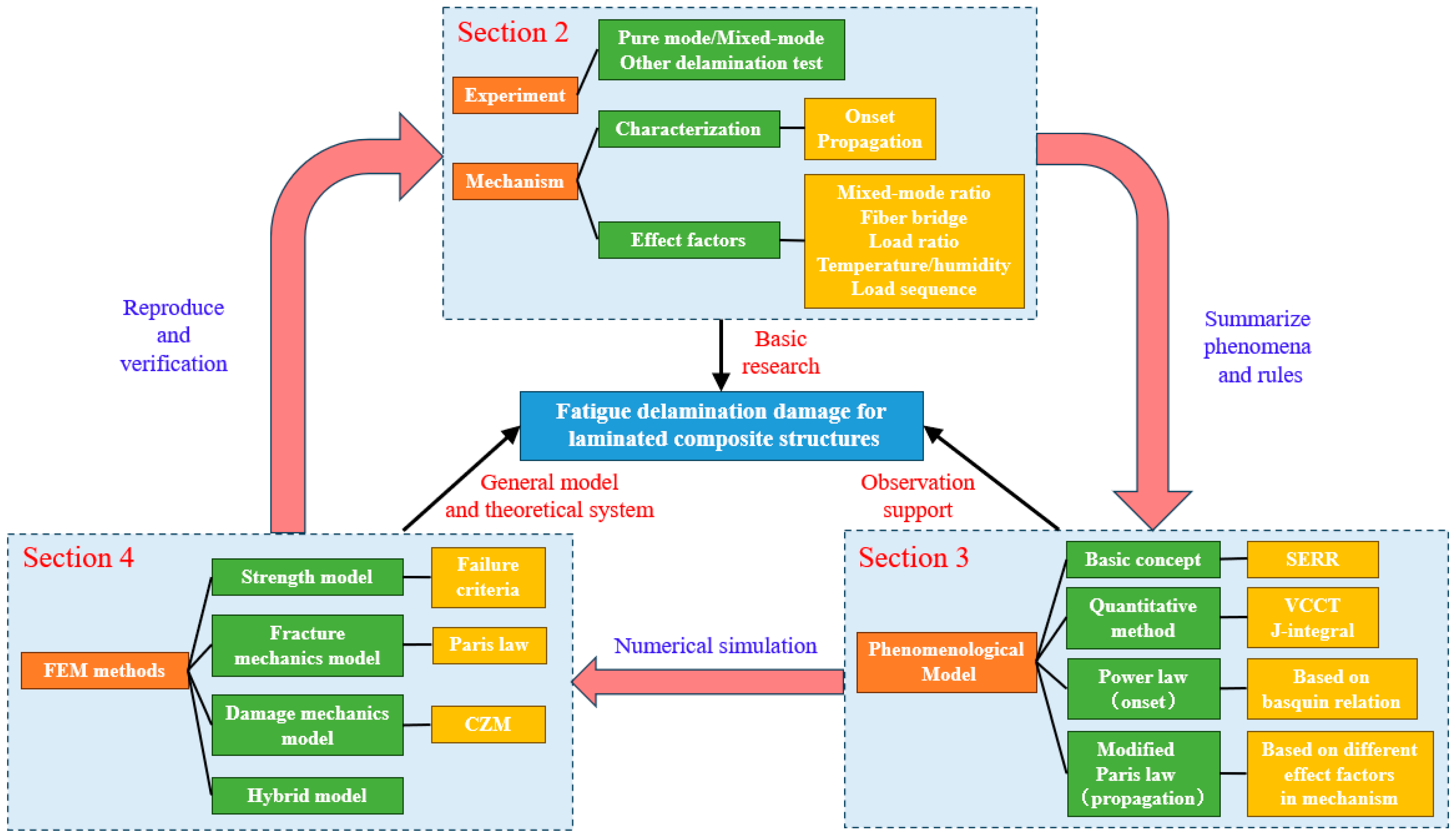




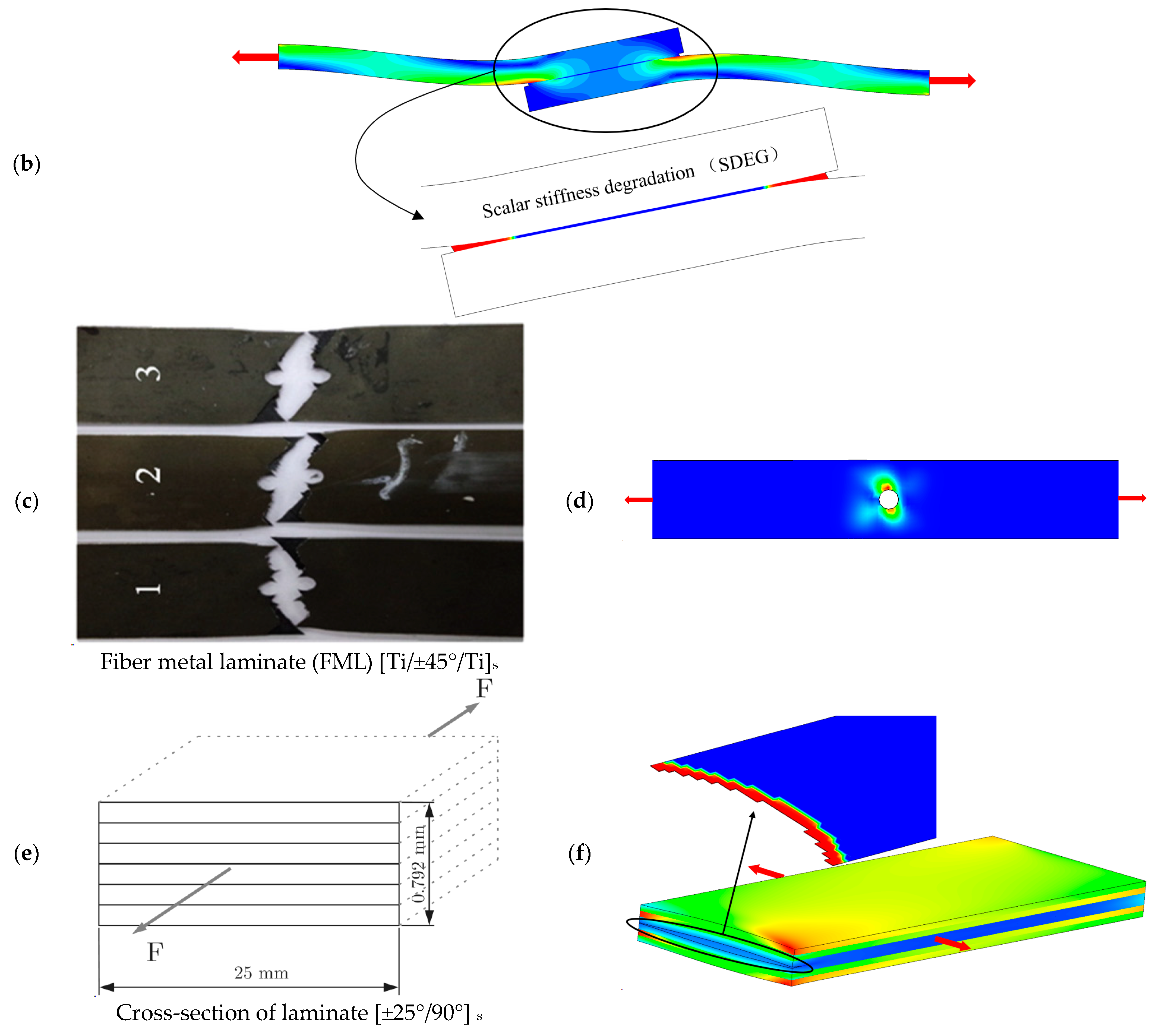



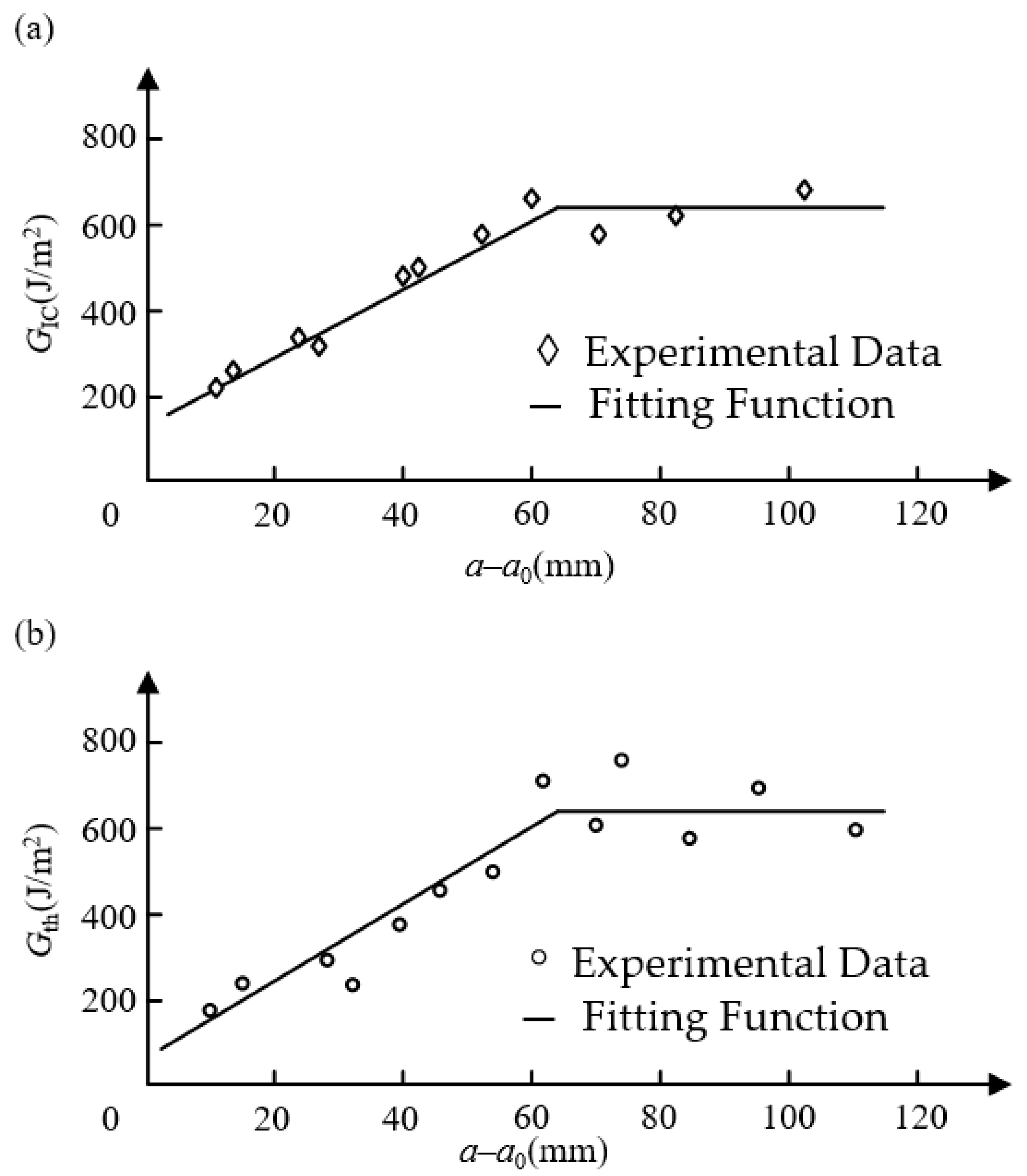
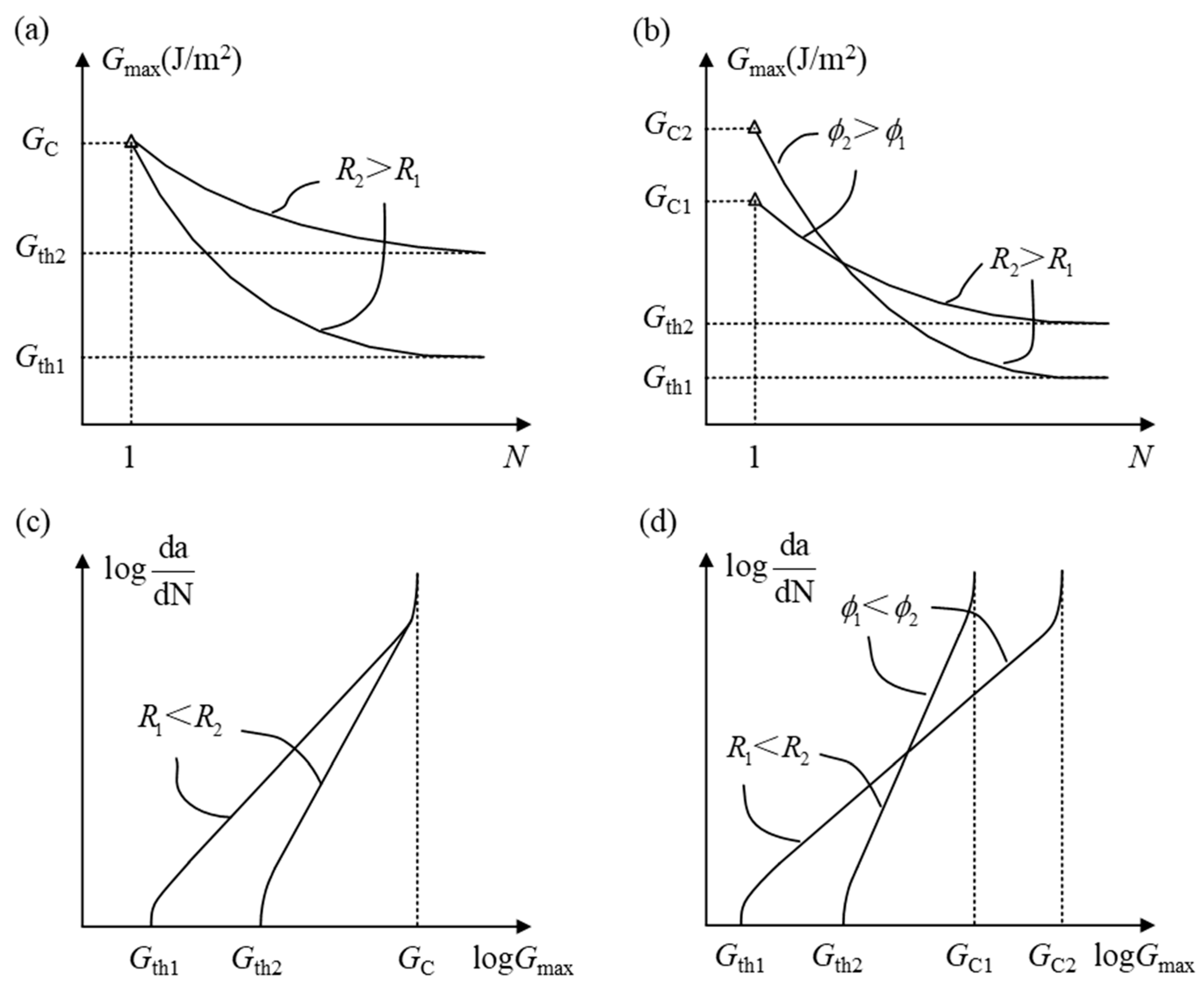

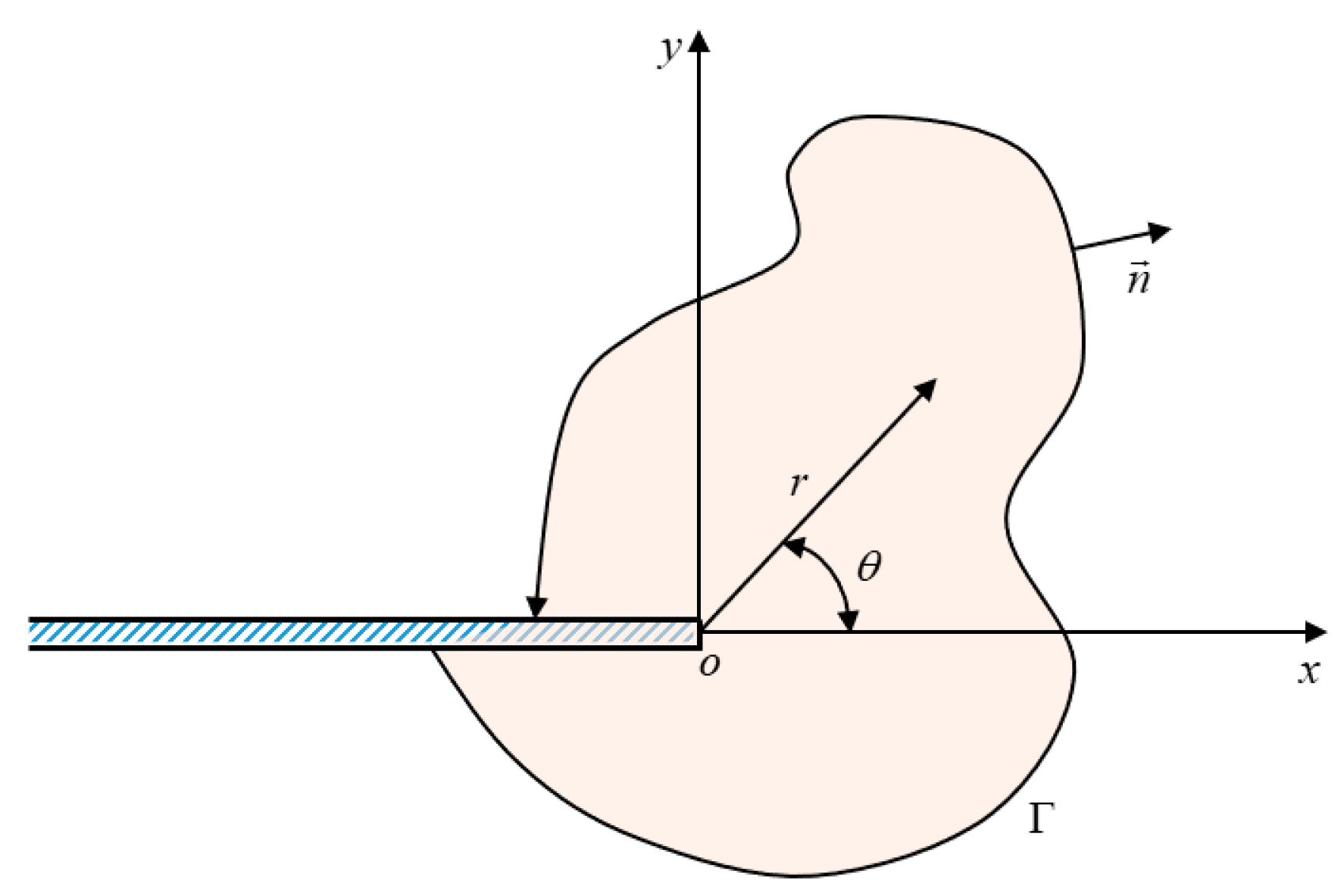

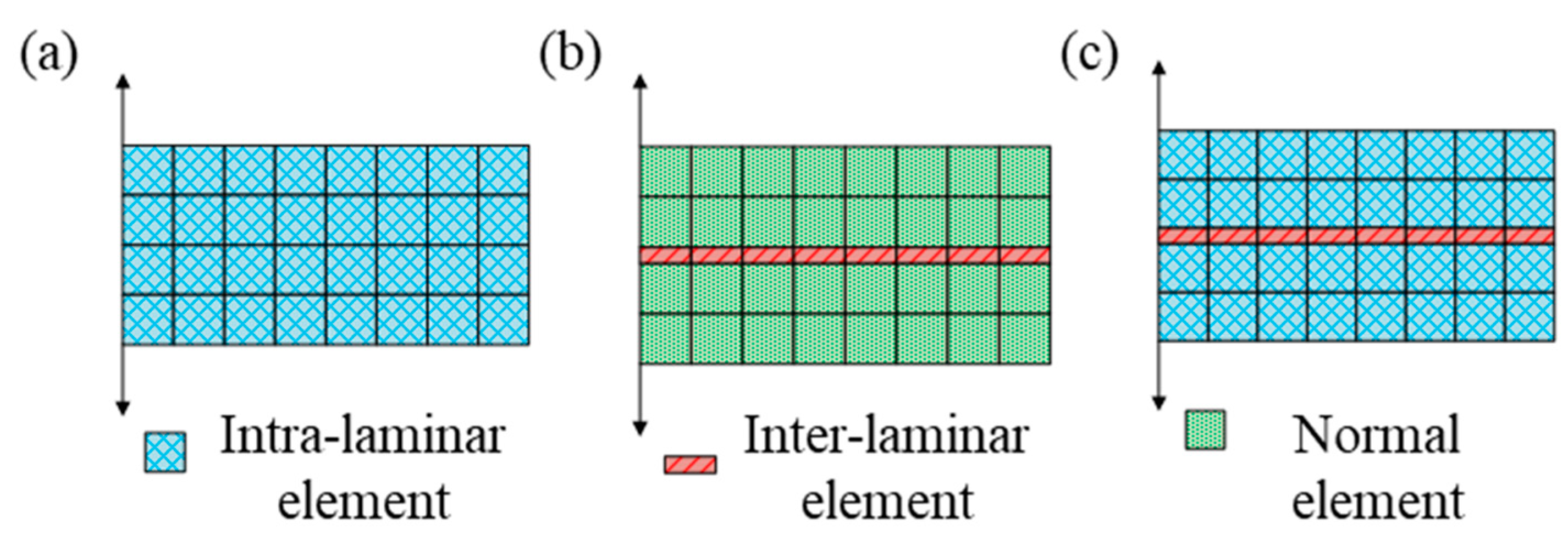
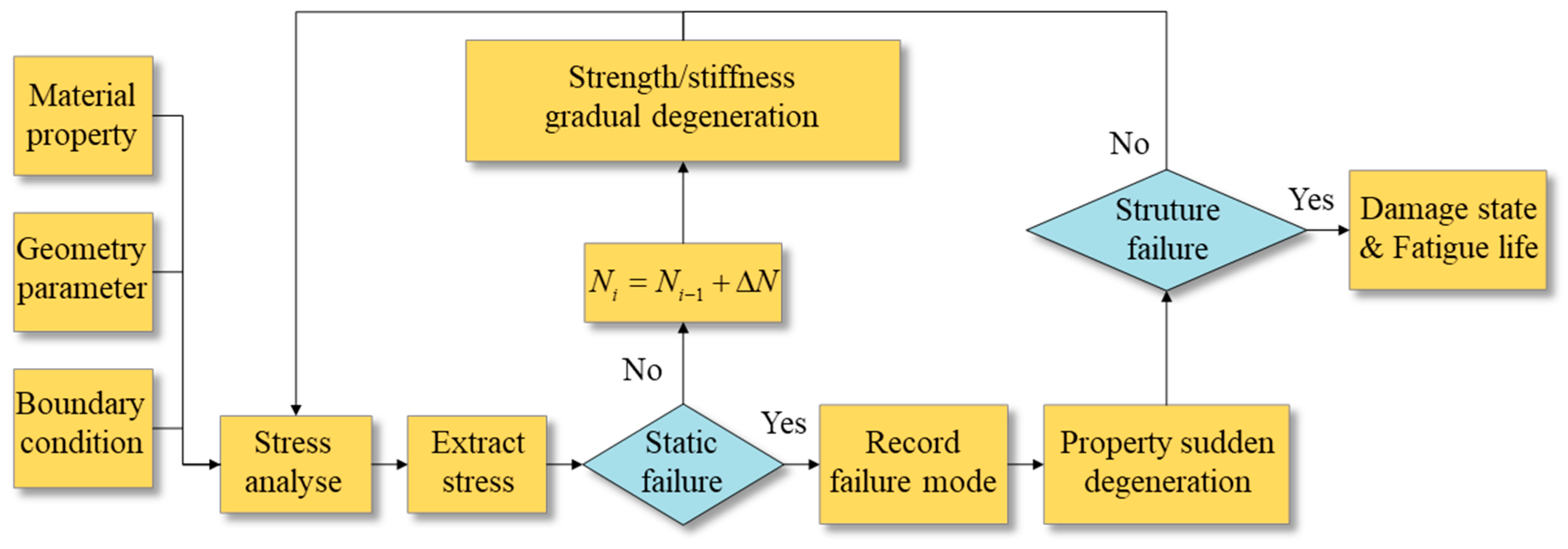
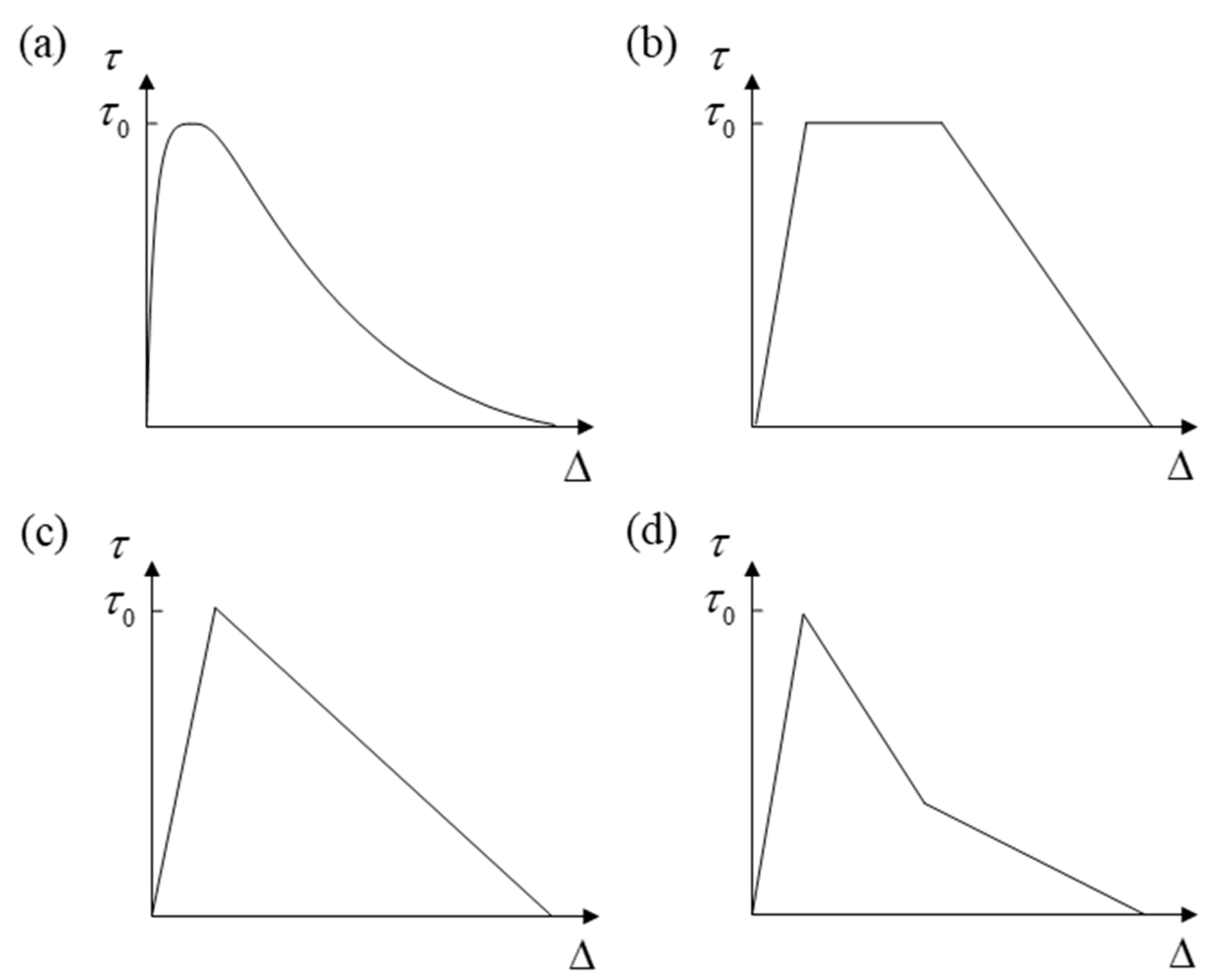
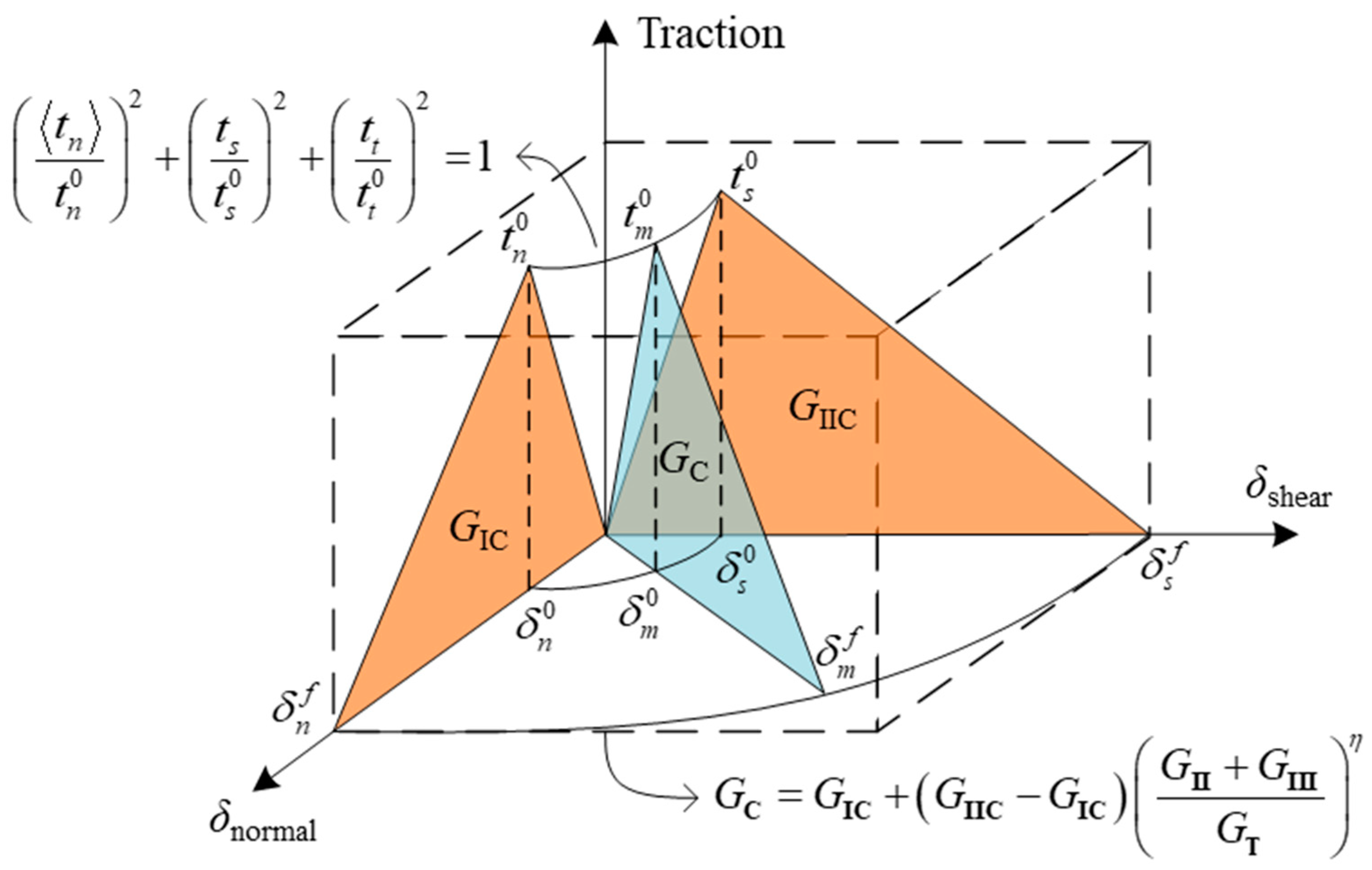

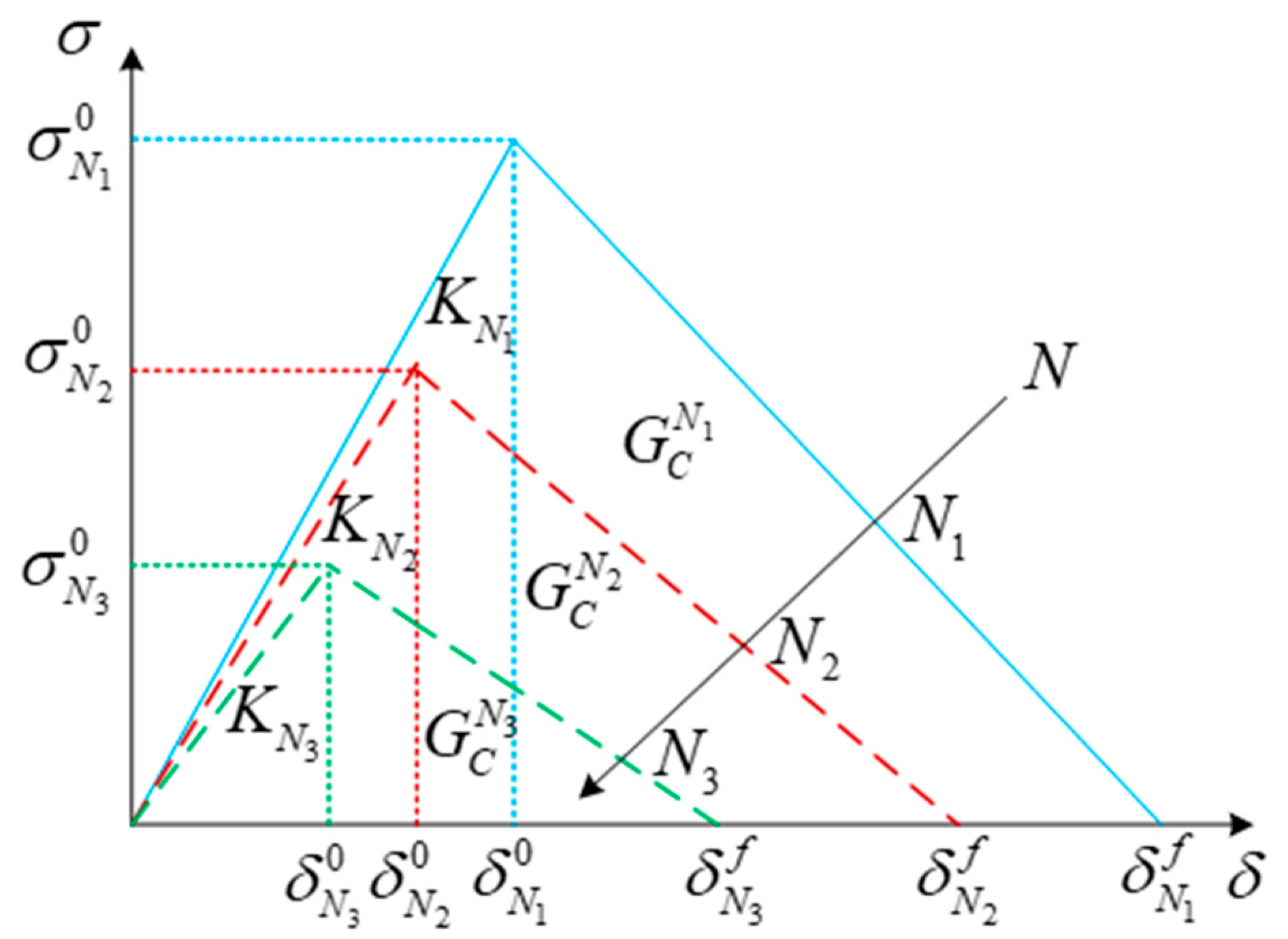

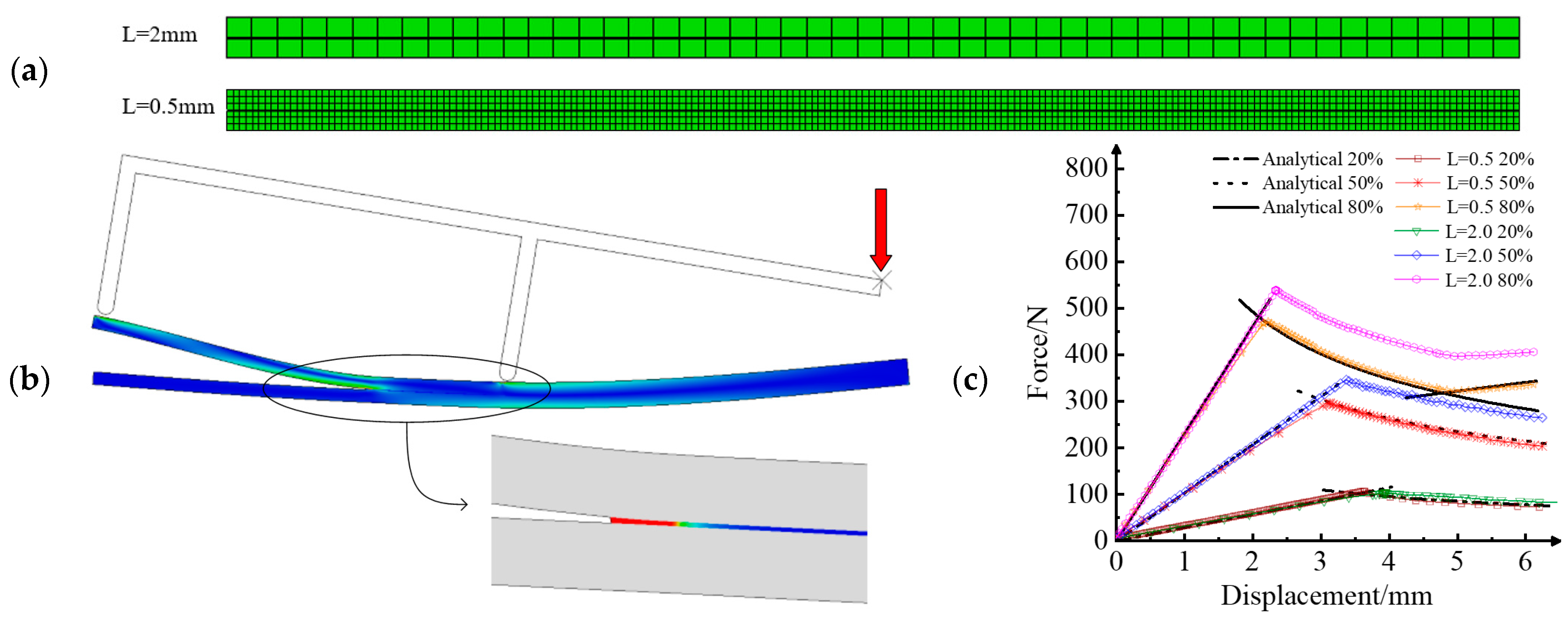
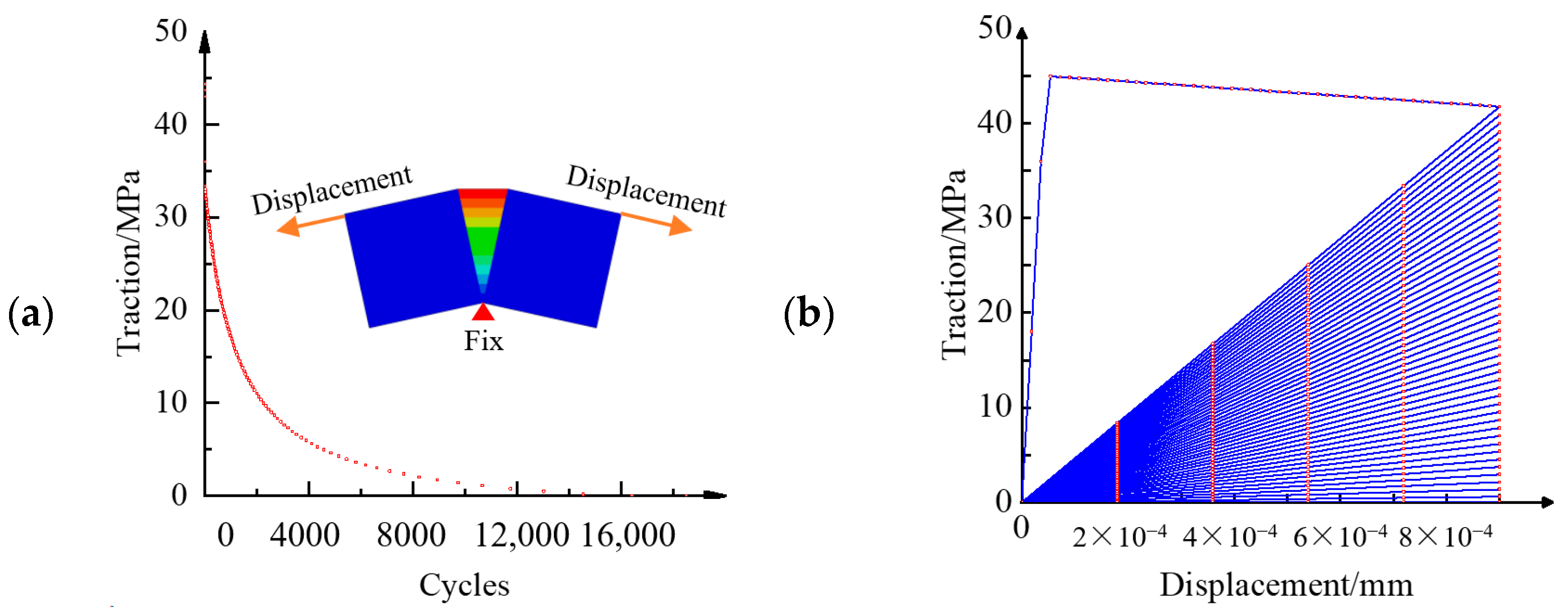
| Criterion | Expression of f |
|---|---|
| Hashin | |
| Chang-Chang | |
| Hou | |
| Zou | |
| LaRC |
| Initiation Criterion | Expression | Evolution Law | Expression |
|---|---|---|---|
| Maximum principal stress/strain criterion | Power law | ||
| Maximum nominal stress/strain criterion | B–K law | ||
| Quadratic nominal stress/strain criterion | Reeder law |
Disclaimer/Publisher’s Note: The statements, opinions and data contained in all publications are solely those of the individual author(s) and contributor(s) and not of MDPI and/or the editor(s). MDPI and/or the editor(s) disclaim responsibility for any injury to people or property resulting from any ideas, methods, instructions or products referred to in the content. |
© 2023 by the authors. Licensee MDPI, Basel, Switzerland. This article is an open access article distributed under the terms and conditions of the Creative Commons Attribution (CC BY) license (https://creativecommons.org/licenses/by/4.0/).
Share and Cite
Deng, J.; Zhou, J.; Wu, T.; Liu, Z.; Wu, Z. Review and Assessment of Fatigue Delamination Damage of Laminated Composite Structures. Materials 2023, 16, 7677. https://doi.org/10.3390/ma16247677
Deng J, Zhou J, Wu T, Liu Z, Wu Z. Review and Assessment of Fatigue Delamination Damage of Laminated Composite Structures. Materials. 2023; 16(24):7677. https://doi.org/10.3390/ma16247677
Chicago/Turabian StyleDeng, Jinghui, Jie Zhou, Tangzhen Wu, Zhengliang Liu, and Zhen Wu. 2023. "Review and Assessment of Fatigue Delamination Damage of Laminated Composite Structures" Materials 16, no. 24: 7677. https://doi.org/10.3390/ma16247677





